The AMD Radeon R9 290 Review
by Ryan Smith on November 5, 2013 12:01 AM EST- Posted in
- GPUs
- AMD
- Radeon
- Hawaii
- Radeon 200
Compute
Jumping into pure compute performance, this is another scenario where the 290X shouldn’t throttle as much, and as such the performance differences between the 290 and 290X should be closer to what they are on paper. With compute workloads the ROPs aren’t being hit hard, so that’s power and thermal savings that lets both cards operate at close to their maximum boost clocks.
As always we'll start with our DirectCompute game example, Civilization V, which uses DirectCompute to decompress textures on the fly. Civ V includes a sub-benchmark that exclusively tests the speed of their texture decompression algorithm by repeatedly decompressing the textures required for one of the game’s leader scenes. While DirectCompute is used in many games, this is one of the only games with a benchmark that can isolate the use of DirectCompute and its resulting performance.
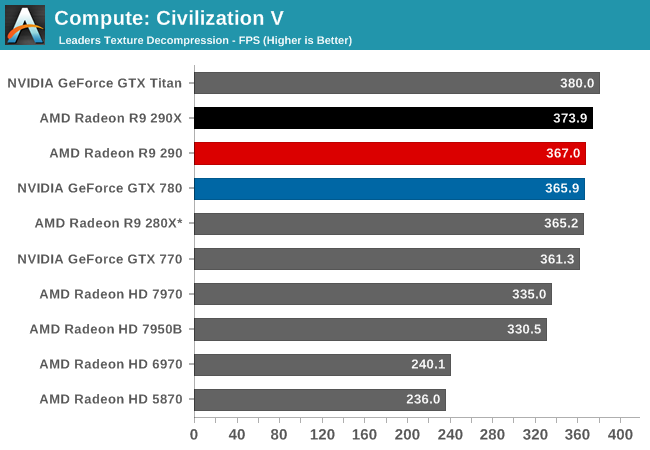
As with the 290X, Civ V can’t tell us much of value due to the fact that we’re running into CPU bottlenecks, not to mention increasingly absurd frame rates. The 290 is marginally slower than the 290X due to the lower clockspeeds and missing CUs, but minimally so.
Our next benchmark is LuxMark2.0, the official benchmark of SmallLuxGPU 2.0. SmallLuxGPU is an OpenCL accelerated ray tracer that is part of the larger LuxRender suite. Ray tracing has become a stronghold for GPUs in recent years as ray tracing maps well to GPU pipelines, allowing artists to render scenes much more quickly than with CPUs alone.
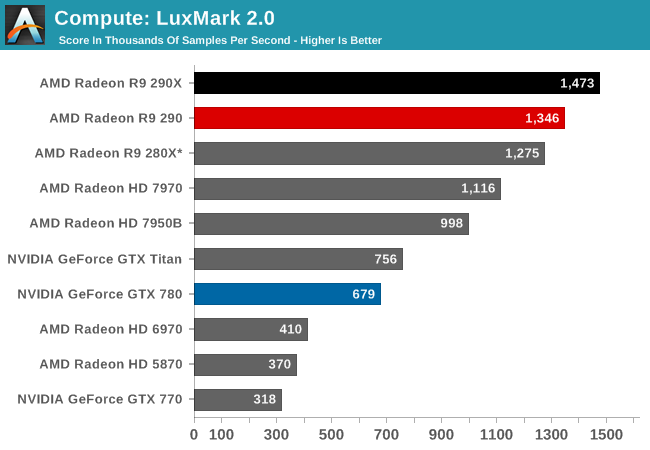
With both cards unthrottled and bound solely by shader performance, it’s an outright foot race for the Radeon cards. 290 trails 290X by around 9%, closely mirroring the difference in the CU count between the two cards. Though 290 is being very closely chased by the 280X, as Hawaii in general seems to have trouble getting the most out of its shader hardware on this benchmark.
Our 3rd compute benchmark is Sony Vegas Pro 12, an OpenGL and OpenCL video editing and authoring package. Vegas can use GPUs in a few different ways, the primary uses being to accelerate the video effects and compositing process itself, and in the video encoding step. With video encoding being increasingly offloaded to dedicated DSPs these days we’re focusing on the editing and compositing process, rendering to a low CPU overhead format (XDCAM EX). This specific test comes from Sony, and measures how long it takes to render a video.
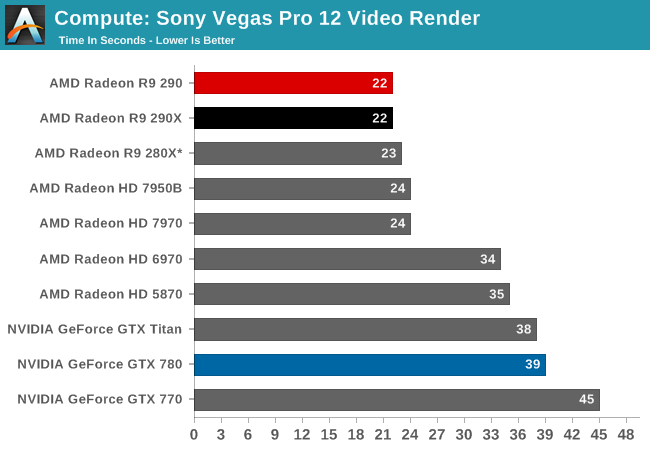
There’s not enough of a GPU performance difference between the two cards to matter with this test. Both tie at 22 seconds.
Our 4th benchmark set comes from CLBenchmark 1.1. CLBenchmark contains a number of subtests; we’re focusing on the most practical of them, the computer vision test and the fluid simulation test. The former being a useful proxy for computer imaging tasks where systems are required to parse images and identify features (e.g. humans), while fluid simulations are common in professional graphics work and games alike.
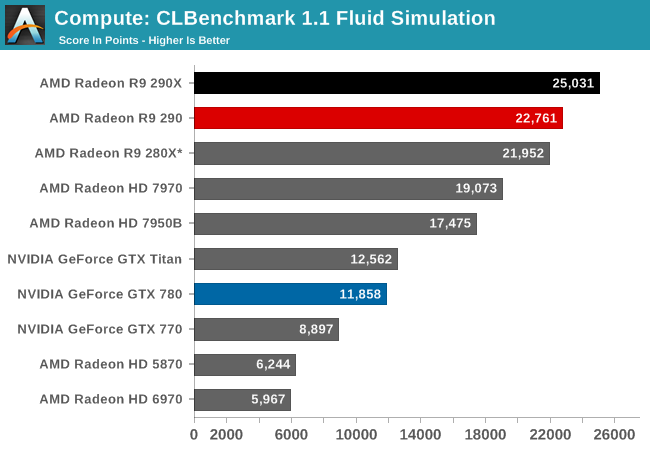

In the CLBenchmark fluid simulation the 290X and 290 take the top spots as expected, with the 290 trailing once more by 9%. However both Hawaii cards are still struggling with the computer vision benchmark, leading to the 290 being edged out by the 7970 of all things.
Moving on, our 5th compute benchmark is FAHBench, the official Folding @ Home benchmark. Folding @ Home is the popular Stanford-backed research and distributed computing initiative that has work distributed to millions of volunteer computers over the internet, each of which is responsible for a tiny slice of a protein folding simulation. FAHBench can test both single precision and double precision floating point performance, with single precision being the most useful metric for most consumer cards due to their low double precision performance. Each precision has two modes, explicit and implicit, the difference being whether water atoms are included in the simulation, which adds quite a bit of work and overhead. This is another OpenCL test, as Folding @ Home has moved exclusively to OpenCL this year with FAHCore 17.
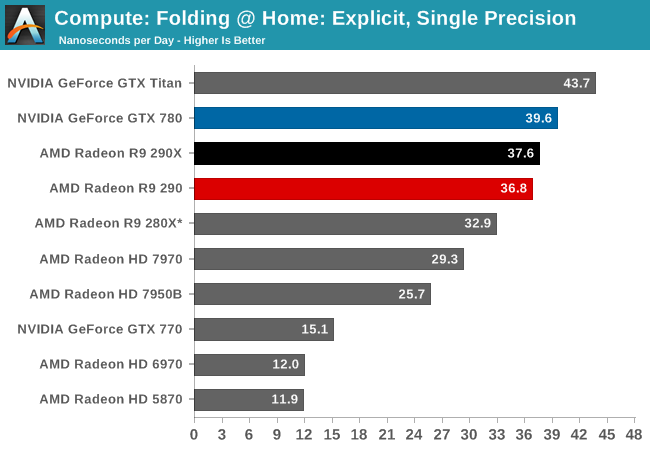
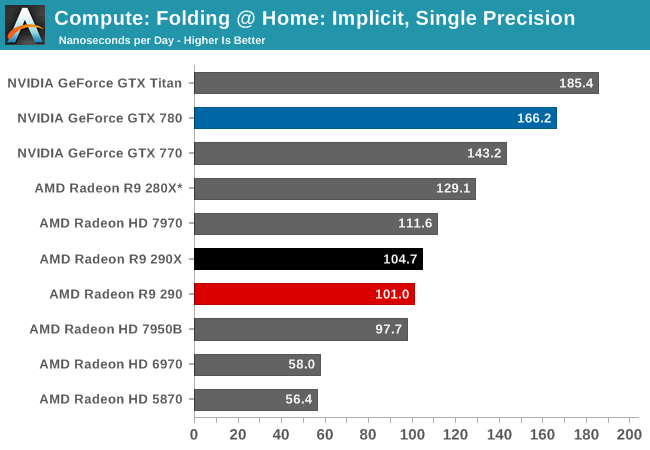
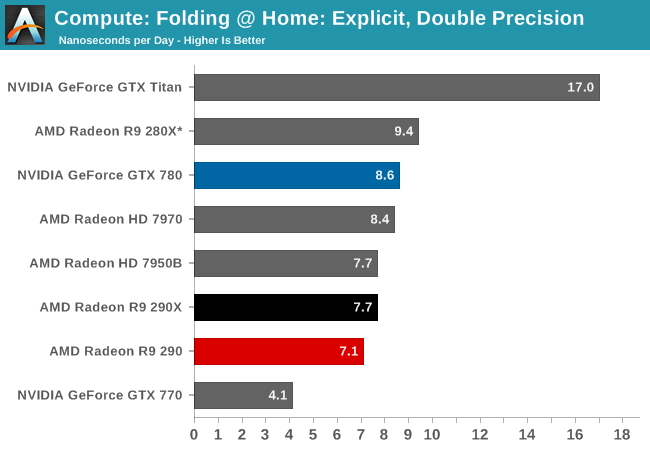
Generally Tahiti and Hawaii are strong performers in the GPU compute arena, but that isn’t of particular help to the 290 here, as it loses out to the GTX 780 in every mode. In single precision FAHBench has trouble putting Hawaii to good use at times, while double precision tests have the 1/8th DP rate 290 and 290X falling behind due to their lower than Tahiti DP throughput.
Wrapping things up, our final compute benchmark is an in-house project developed by our very own Dr. Ian Cutress. SystemCompute is our first C++ AMP benchmark, utilizing Microsoft’s simple C++ extensions to allow the easy use of GPU computing in C++ programs. SystemCompute in turn is a collection of benchmarks for several different fundamental compute algorithms, as described in this previous article, with the final score represented in points. DirectCompute is the compute backend for C++ AMP on Windows, so this forms our other DirectCompute test.
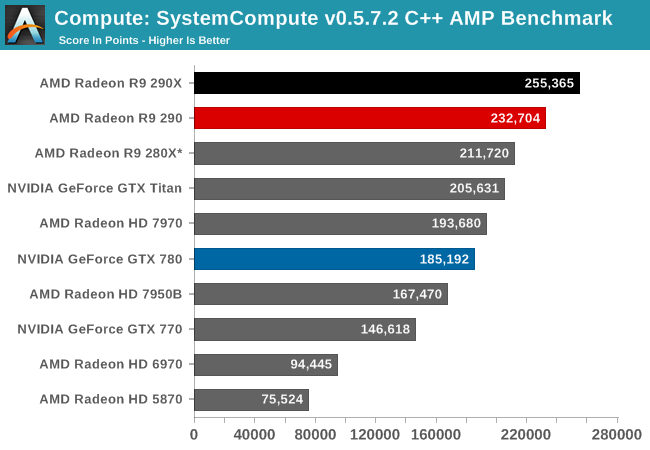
SystemCompute is another benchmark where 290 and 290X do not experience meaningful throttling, and as such are separated by more than what happens in our gaming benchmarks. In this case 290 yet again trails 290X by 9%, though it still enjoys a considerable lead over the GTX 780 and all other NVIDIA cards.










295 Comments
View All Comments
kwrzesien - Tuesday, November 5, 2013 - link
I would agree with you if the 280X was actually a re-spin of the Tahiti silicon and included TrueAudio and whatever other IP and low-level changes come with the Hawaii die, just with Tahiti configuration and speed. Unfortunately it's not, and is already out of date.I was hoping that the 290 would be the perfect solution with all the newest features but cut down to reasonable power/temp/noise limits - but that is not to be. Maybe they need a 290L.
cactusdog - Tuesday, November 5, 2013 - link
I thought most people bought custom cooler highend cards these days anyway, unless you're on water. The reference cards don't seem to last very long, if you look on newegg for current cards like NVidia 7 series and AMD 7970 etc, most cards on sale are non-reference models. For some models you cant find a reference model. Personally, I haven't bought a reference blower cooler for a couple of generations, even the "quiet" versions are much louder than a good non reference cooler like Twin frosr, Asus DCUII or Sapphire Toxic and Giga Windforce.Braincruser - Tuesday, November 5, 2013 - link
nVidia is in no trouble, even if it doesn't sell a single card anymore, all it has to do is move to making hearing aids.Conduit - Tuesday, November 5, 2013 - link
Anandtech showing it's ignorance as usual. This is THE high end card to get right now, who cares if it's loud? Most people game with headsets so won't even hear it in game.Homeles - Tuesday, November 5, 2013 - link
"it's ignorance"Lol. A bit of a hypocrite, are we?
Da W - Tuesday, November 5, 2013 - link
Dear ASUS, MSI, XFX, HSI and others.I usually purchase AMD to help them stay alive.
You have until Christmas to come up with a 290X card using a Nvidia 780 style cooler, or even a water cooler unit by default.
Else i will make due with a GTX 780 and their better bundle of game.
Conduit - Tuesday, November 5, 2013 - link
Don't worry lol, there is still 7 weeks to go until Christmas, if they can't get out custom cooled cards by then then they deserve to get bankrupt.ruthan - Tuesday, November 5, 2013 - link
I personally prefer fanless solution, but if you need performance, i cant use it.. But those cards, are abomination of the week.We need performance gained by better effectivity, not by add other 50Watss power and vacuum cleaner fan inside.
I think that resonable power consumation limit is around 150W, this could be cooled, by big passive cooler and 2-1000 RPM Noctua or others quit fans.
coldpower27 - Wednesday, November 6, 2013 - link
I wish we could just stick to 150W but with this many transistors of computing it just isn't possible. Your probably won't get this level of performance at 150W till next generation.piroroadkill - Tuesday, November 5, 2013 - link
Dear AMD,Please either:
a) make sure you launch with the option of blower AND open quiet cooler
b) make sure you launch with partner custom cards
c) give up making blowers
These cards clearly have headroom and are incredible value. Don't give people a reason to moan about them.